it does not look likely to stir a man’s soul,
‘Tis the deeds that were done ‘neath the moth-eaten rag,
When the pole was a staff and the rag was a flag.”1
This book on Traditional British Colours was issued by the British Colour Council in commemoration of the Coronation of His Majesty King George VI and Her Majesty Queen Elizabeth.
The Foreword tells us that:
“Here are illustrated colours which for centuries have been bound up with the history of Britain. Our national pride and patriotism demands that we should cherish these colours as part of our national life and preserve them in all the freshness and beauty of their original state for future generations.
Of many of the colours, strange and wonderful tales are told, stories which stir the imagination and recall the glories of the past; something of the meaning and history of these colours is given in the following pages, while the actual colours have been faithfully reproduced on ribbon from actual records of flags, banners and orders preserved throughout the ages.”
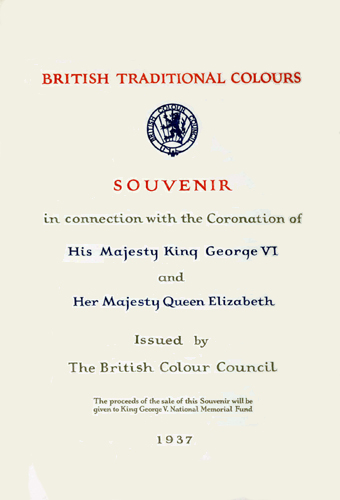
The copy that I own is No 24 of the Edition de Luxe of 250 copies, each numbered and signed by The Earl of Derby, Patron of The British Colour Council.
It displays a number of coloured ribbons, which had originally appeared in the Dictionary of Colour Standards, which the Council had published in 1934 in two volumes. One of these showing 220 colours presented on pure silk ribbon, named, numbered, and coded, and the other giving the history of each colour, the various names by which each had previously been known and the authority for standardisation.2
The colours were shown in the following sections:
1) The Colours of the Union Flag;
2) The Colours of the Ribbons of the Most Noble Orders of Knighthood of Great Britain;
3) Bunting Colours of the British Navy;
4) The Colours of the British Army;
5) Colours of the Royal Air Force;
6) Heraldic Colours, and
7) Tartan Colours.
As well as these categories there was also a page displaying the coloured velvet of the robes that were to be worn during the Coronation Ceremony at Westminster Abbey. One sample was of “The actual material which will be used in the robes of Their Royal Highnesses The Duchess of Gloucester and The Duchess of Kent“. The other (redder) sample was of “The actual material which will be used in the robes of the Peers and Peereses attending the Abbey Ceremony”.
CORONATION SPECIAL 1937
The text that preceded the colour samples was written by Robert F. Wilson, the Director of the Council. He gave a brief history of the use of colour in national emblems from ancient times to about 1800 and expanded upon each of those used to illustrate the book.
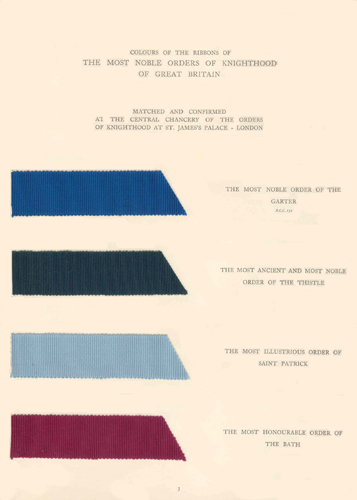
An account of the Order of the Garter, with its distinctive blue sash was given, and this was followed by a description and background to the Orders of The Thistle (green), St Patrick (light blue) and the Order of the Bath (red). Each of these colours had been matched and confirmed at the Central Chancery of the Orders of Knighthood at St James’s Palace, in London.

The Army was well represented, being given 14 colours, which included 3 crimsons, a scarlet, a red, 3 greens, a blue, 2 buffs, a yellow, a saffron and a maroon.
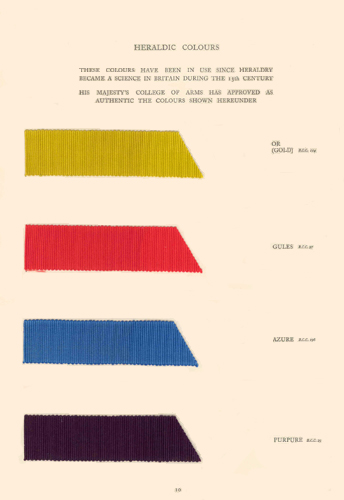
There are five colours used in heraldry and two metals. Metals when not shown in gold or silver are represented by yellow and white respectively. It is one of the rules of heraldry that colour should not be placed on colour nor metal on metal and great care therefore, has to be taken in the use of white and gold in flag designing which is, strictly speaking, a branch of heraldry.
More information on the colours or tinctures can be found elsewhere on this site.
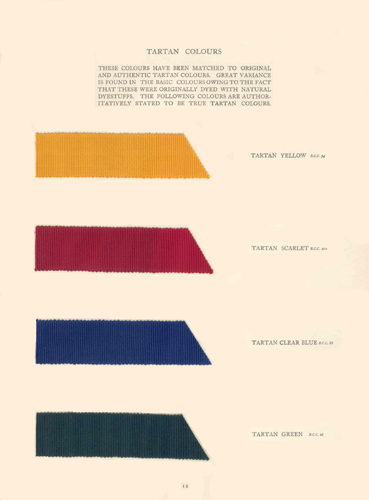
We are told that the two pages of tartan colours had been matched to original and authentic tartans. Great variance was found in the basic colours owing to the fact that these were originally dyed with natural dyestuffs. Eight colours were shown – the four above and a light blue, Stewart blue, brown and blue.
The colours used for dyeing these distinctive colours were obtained from various shrubs and flowers. They are described as being “the completion of their landscape and their traditional colours were very intimately connected with their ‘native heath’.”
The dyes employed came from a wide variety of vegetal sources and included blues from the blaeberry; purples and crimsons from certain lichens; red from alder bark, rue and privet; green from broom, heather, buckthorn and whin; orange from ragwort and barberry; yellow from ash, sweet gale and teasel; black from iris root and alder bark.
The Psychological Meaning of Colour
Mr Wilson then wrote about the psychological meaning of colour in order that one might have a clearer understanding when planning street decoration.
The characteristics of Red, Blue and Yellow are respectively, heat, cold luminosity.
RED…
“…is the colour of fire and blood, and denotes action, life and enthusiasm. Throughout the ages it has been used by healers as a powerful stimulant and tonic, and is generally associated with health and vigour.
Taken to extremes of boisterous health, red becomes a sign of exuberant animal spirits and it was in this sense that the phrase arose “to paint the town red.”
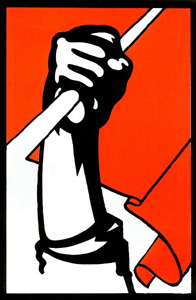
It is again in the extreme sense of active revolution that it came to be used as the red flag of mutiny and rebellion, and this illustration still stands to-day.”
BLUE (he told us)…
“…has an intellectual or spiritual appeal as opposed to the physical appeal of red. Symbolically it is the colour of truth – ‘true blue’ – which is the result of calm reflection and never of heated argument.
The Egyptian judges wore breast plates of blue; the robes of the priests of Atlantis were also of that colour; while Moses was commanded to bid the Children of Israel to put a riband of blue on the fringe of their garments that they might remember to ‘do all My comandments.’
As red, – representing physical high spirits carried to excess – loses its virtue, so in all colour symbolism there are two meanings – one exalted, the other debased.
Intellectual blue may come to represent hardness or cruelty if it becomes ‘steel blue’ and a person particularly susceptible to the emotion attributed to blue may easily become a victim of ‘the blues’ than one whose emotions seek other colours. The designation a ‘blue stocking’ is applied to a person who has cultivated intellect to the exclusion of affection.”
YELLOW…
“…the colour of the sun carries the attributes of splendour and radiance. In some countries the wearing of yellow is a sign of high rank, while to the Ancients it was the greatest of all colours and had the most exalted meaning.
In its degraded meaning it is the saddest of colours as it symbolises poorness of life and separation, and it is in the sense of sickness that this colour is used when the Yellow Flag is hoisted as a sign of fever.”
ORANGE…
“…combines the strength of red with the luminosity of yellow. Thus it expresses the positive virtues of health, energy, warmth and activity.
Although rarely used in flags, orange is a particularly gay colour for use in street decoration where its qualities can convey their meaning with a happy effect.”
GREEN…
“…commonest of all colours in nature combines in its mixture of blue and yellow the wisdom and peace of the former with the latter’s qualities of unity and eternity. Time to the Egyptians is known as ‘The Everlasting Green One’. Here it is interesting to note that shipwrecks are marked with a green flag.”
PURPLE…
“…is a combination of red and blue and so blends the physical with things spiritual. In this way it becomes symbolical of death – the gateway between the ‘material’ and spiritual. In this sense it should only be used on solemn occasions and never on occasions of rejoicing.
Purple is definitely a ‘Royal Colour’ and its use should be restricted at the time of a coronation so that it reaches its full significance by being used only in the Royal Robes. Its symbolism being in this instance – the red of love and self sacrifice with the blue of truth.
The attribute of wisdom is also associated with purple being mentioned as the colour of the canopy of Solomon’s chariot, while from earliest times it has been part of the insignia of Royalty. In the days of the Roman Empire, the use of cloth dyed to this colour was confined to members of the Royal Family – hence the saying ‘Born into the Purple.’
Colour in Street Decorations
The main purpose of this extraordinary book was to provide guidance on the decoration of streets in order to celebrate the Coronation.
The principal factors which should be taken into account when considering street decorations were given as:
1. The decoration of existing buildings, already decorative in themselves.
2. The erection of standards and pylons with linked chain decorations.
3. Lighting.
A number of commonsense suggestions were made, which might best be summarised in the following principle:
Wilson ends with a section on tradition and the antiquity of the insignia and symbols seen at the Coronation -
“Kings, Princes, Lords and commoners have lived and passed on – only the few are remembered – but the influence of our national symbols and emblems lives for all time.”
Current Availability of Colours
As with almost all the colours shown on this site those shown here could be mixed into conventional modern paint by Papers and Paints Ltd
Notes
1 Sir Edward Hamly on seeing some old Colours of the 32nd Foot in Monmouth Church.
2 This was superseded by The Dictionary of Colours for Interior Decoration in 1949.
View Larger Map


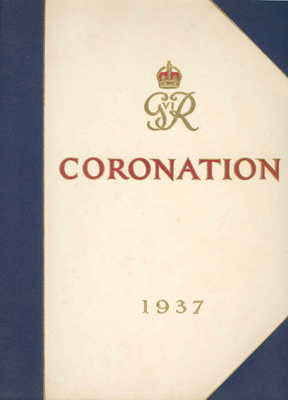
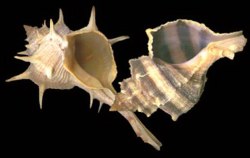
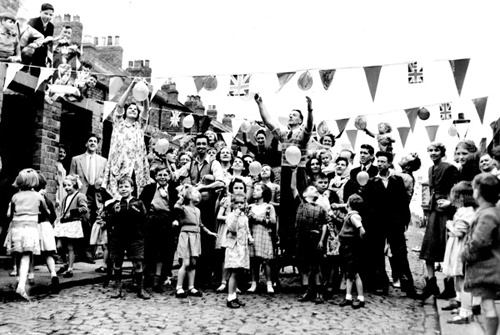










Having just rediscovered the family copy (No 14 of 250), was amazed to find such a recent entry.
This copy originally belonged to:
McCallum’s
Laighpark Dyeworks
Paisley
How wonderful. It’s a great book and very uncommon.